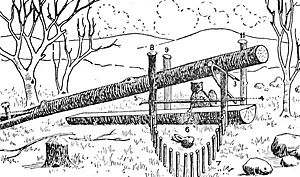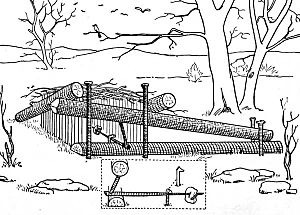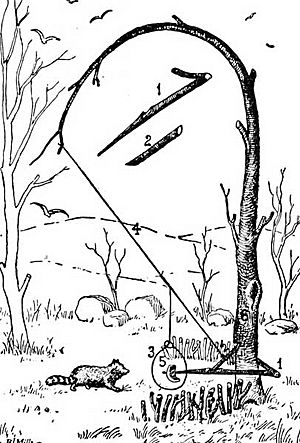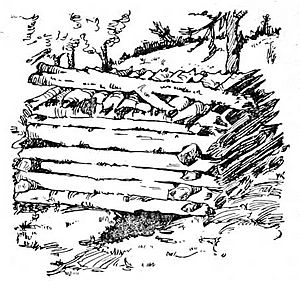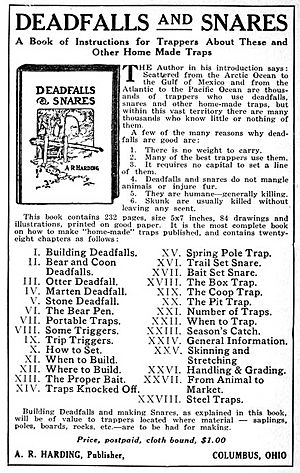Deadfalls and Snares facts for kids
Deadfalls and Snares: A Book of Instruction for Trappers About These and Other Home-Made Traps is a book from 1907 by A. R. Harding. It teaches people how to build simple traps using natural materials like logs, boards, and rocks. These traps are called "deadfalls" and "snares." The book also shows how to catch different animals, from small ones like skunks and raccoons to larger ones like bears. It even includes tips on how to handle animal furs after they are caught.
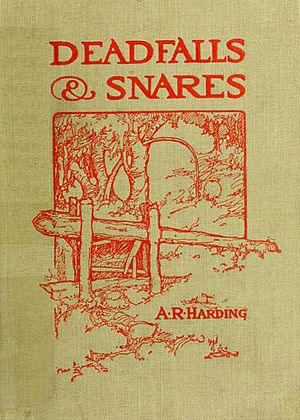
Deadfalls and Snares Cover (1907)
|
|
| Author | Arthur Robert Harding |
|---|---|
| Country | United States |
| Language | English |
| Publisher | A. R. Harding Publishing Co. |
|
Publication date
|
1907 (copyright) |
| Media type | Print (hardcover) |
| Pages | 232 pp |
| Preceded by | Mink Trapping |
| Followed by | Steel Traps |
Contents
What the Book is About
Deadfalls and Snares is part of a series called "Harding's Pleasure & Profit Books." It was first published in 1907. The book is a guide for people who want to learn about trapping. It focuses on how to build "deadfalls" from logs, boards, and rocks. It also teaches how to make "snares" and "toss poles." These traps are used to catch many kinds of furbearers, such as skunks, opossums, raccoons, minks, martens, and even bears. The book also covers "coop traps" for catching wild turkey and quail.
The author, A. R. Harding, believed that many trappers around the world used homemade traps. However, he felt that many American trappers did not know much about them.
The book has 50 detailed drawings. These pictures show different ways to build deadfalls using logs, boards, or stones. They also show "coop" or "pen" style traps and various trigger designs. You can also see how to set up snares. Besides building traps, the book also has chapters on how to skin animals. It teaches how to stretch, handle, and sort fur pelts. There's even a list of old-fashioned steel traps from the early 1900s.
The instructions for building, baiting, and setting traps come from different trappers. These experts are from various parts of America and Canada. Their names are not fully given, only their home country or state.
Interesting Parts and Pictures
From Chapter One
One trapper in the book says that trapping is an art. He believes that a good trapper should know how to build and set a deadfall when needed. He shares many reasons why deadfalls are useful:
- You don't need to carry heavy traps.
- Many skilled trappers use them.
- You don't need money to set up many deadfalls.
- Your traps won't be stolen, but the fur might be.
- Deadfalls don't hurt animals badly or damage their fur.
- It's a kind way to kill animals.
- Animals can't twist free and escape.
- Animals are killed quickly, so they can't warn others.
- Trappers always have the tools (axe and knife) to build a deadfall. These can catch even the largest animals.
- Even big deadfalls can be set to catch small animals easily.
- Deadfalls can catch skunks without them spraying their scent.
- Deadfalls are cheap, and trappers should know how to use them.
The author also mentions that many trappers back then didn't know how to build a deadfall or make snares. Some had never even seen one.
From Chapter Eight
One trapper shares a story about visiting an old trapper. He had only used one type of trigger, called the "figure 4." But this old trapper used a different kind, called the "prop and spindle." He saw that two of the old trapper's traps had caught a skunk and an opossum. This made him realize that these new triggers worked well. After that, he started using the "prop and spindle" triggers instead of the "figure 4."
From Chapter Twelve
An Arkansas trapper explains how to build a great deadfall. He says it will catch every mink and raccoon that comes by the creek. He describes using a pole four feet long and four inches thick. Then, a log six inches thick and eight feet long is needed. You also need eight stakes and two "switches" (flexible branches). He suggests using a "figure four trigger," but with special cuts. The "paddle part" of the trap should be sixteen inches long. When set, the paddle needs to be level and slightly higher than the side logs. The two switches help keep the paddle from hitting the bark on the side logs.
Chapters in the Book
Here are some of the topics covered in the book:
- Building Deadfalls
- Bear and Coon Deadfall
- Otter Deadfall
- Marten Deadfall
- Stone Deadfall
- The Bear Pen
- Portable Traps
- Some Triggers
- Trip Triggers
- How to Set
- When to Build
- Where to Build
- The Proper Bait
- Traps Knocked Off
- Spring Pole Snare
- Trail Set Snare
- Bait Set Snare
- The Box Trap
- The Coop Trap
- The Pit Trap
- Number of Traps
- When to Trap
- Season's Catch
- General Information
- Skinning and Stretching
- Handling and Grading
- From Animal to Market
Publication Details
The book was first published by A. R. Harding Publishing Company in Columbus, Ohio. This happened on July 11, 1907. You can still find new versions of this book from different sellers today.


